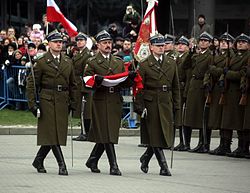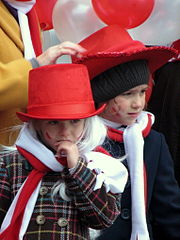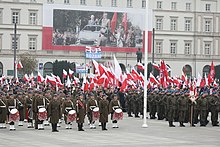National Independence Day (Poland)
| National Independence Day | |
|---|---|
11 November | |
| Next time | 11 November 2024 |
| Frequency | Annual |
National Independence Holiday (Polish: Narodowe Święto Niepodległości) is a national day in Poland celebrated on 11 November to commemorate the anniversary of the restoration of Poland's sovereignty as the Second Polish Republic in 1918 from the German, Austro-Hungarian and Russian Empires. Following the partitions in the late 18th century, Poland ceased to exist for 123 years until the end of World War I, when the destruction of the neighbouring powers allowed the country to reemerge. It is a non-working day and a flag flying day in Poland.
Historical background

The restoration of Poland's independence was gradual. On 5 November 1916 the
Crucial to restoring independence was the defeat in the war of all three of the occupying powers.[3] Russia was plunged into the confusion of revolution and civil war, Austria-Hungary disintegrated and went into decline, and the German Empire bowed to pressure from the forces of the Entente.[4] For Poles, this was a unique opportunity to reclaim their independence. On November the 10th
It was a day of military ceremony since 1920.
The date coincides with the celebration of the Armistice in other countries.[12] All of these holidays and Polish Independence Day are indirectly related because they all emerged from the circumstances at the end of World War I. In other countries, holidays were established in the spirit of grief and horror at the enormous human cost of the war, and they mark the sacrifices of those who fought. For Poland, however, the tragedy of the war was tempered by what had been accomplished at its end: the restoration of a sovereign Polish state that had been lost entirely in the partitions of Poland, after 123 years of struggle.[13] The Polish holiday is therefore simultaneously a celebration of the reemergence of a Polish state and a commemoration of those who fought for it.


National celebrations
Presided by the
The parade formation is formed up into:
- 1st Battalion
- 1 Honor Guard Company (Presidential Joint Service), 1st Guards Battalion, Representative Honor Guard Regiment of the Polish Armed Forces
- Honor Guard Company, Polish Land Forces
- Honor Guard Squadron, Polish Air Force
- Honor Guard Company, Polish Navy
- Honor Guard Company, Polish Special Forces
- Warsaw Capital Garrison Command Honor Guard Company
- Honor Guard Company, Polish Territorial Defence Forces
- Honor Guard Company of the Armed Forces Support Inspectorate
- Honor Guard Company of the Military Gendarmerie of the Armed Forces
- Representative Central Band of the Polish Armed Forces
- 2nd Battalion
- Honor Guard Company of the Border Guard Service
- Honor Guard Company of the Polish Police
- Honor Guard Company of the State Fire Service
- Honor Guard Company of the Customs Service of the National Revenue Administration
- Honor Guard Company of the Prisons Service
- Honor Guard Company of the Marshal's Guard of the Sejm
These formations, except for the 1 Honor Guard Company (Presidential Joint Service), have extra two personnel for the guard mounting segment in front of the Tomb of the Unknown Soldier, which is during the ceremony proper. Behind the formations is the RHGR's State Honors Artillery Battery, whose 4-5 vintage First World War field guns are stationed.
The ceremony begins at 10am, before that the
- Mr/Mrs President, sir/ma'am, the Chief of the General Staff (states rank and name) informs you that the ceremonial guard mounting and parade of the Warsaw Capital Garrison in honor of the (states numbering) anniversary of the restoration of national independence of the Republic of Poland has been formed up and is now ready for your inspection, sir/ma'am.
The report received, the President then inspects the two battalions of the parade joint regiment, which had just presented arms at the order of the parade commander. He/she stops to render honors to the ceremonial colours of each of the units that compose the parade. After all have been inspected, the President then stops at the center of the square nearest the presidential grandstand to greet the formations:
- President:Greetings, servicemen and women!
Parade formation: Good morning, Mr/Mrs President, sir/ma'am!
Following this both the President and the Chief of the General Staff proceed to the south end facing the Tomb of the Unknown Soldier to render honors to the Unknown Soldier of the Polish War of Independence buried there in 1925. Another contingent of battalion size is present, representing military veterans, reservists and the
- Prime Minister of Poland
- Marshals of Parliament (Sejm and the Senate), deputies and senators
- Service commanders and general and flag officers under the Ministry of National Defense and the Armed Forces General Headquarters
- Ministers and deputy ministers
- Commanders of the public uniformed security organizations
- The diplomatic corps, religious representatives and if present representatives from NATO armed forces
- Veterans of the armed forces the public uniformed security organizations and relatives and family members of fallen service personnel
- If present, representatives from state firms and the private sector
Ceremony


The parade commander then shouts For the raising of the national flag, colour guard, take post! to commence the flag raising ceremony segment, in which three servicemen from 1 Honor Guard Company (Presidential Joint Service), 1st Guards Battalion, RHGR-PAF, then march off from their positions to take their place at the square's central flagpole. As they stop and the Flag of Poland is unfurled another fanfare is sounded and following the command In honor of the anniversary of the restoration of the independence of the Republic of Poland, colour guard, raise the national flag! the RCB-PAF's musicians, together with the singers of the Symphony Orchestra and Choir of the Armed Forces, perform the National Anthem Poland Is Not Yet Lost.
Following this, a serviceman from the Warsaw Garrison Command reads in public the Act of National Remembrance of and to the Fallen (Apel Pamięci), in which the parade remembers the millions of Polish war and civilian dead in the wars and conflicts fought by the Polish nation and people over the years. When the reading is completed a 21-gun salute is fired as 3 Scouts and Guides escort a ceremonial candle from the square to the Tomb of the Unknown Soldier as the tribute of the nation's young men and women to the memory of the millions who perished for country and people. The Armed Forces Memorial Fanfare (Haslo Wojska Polskiego) is then sounded.
Guard mounting at the Tomb

The act of remembrance finished the parade commander then prepares the companies for the solemn guard mounting at the Tomb of the Unknown Soldier. Each of the company commanders, save that of 1 Honor Guard Company (Presidential Joint Service), after having taken their posts at the center of the square and with the parade now at the order arms position and then ordered at ease, then inform him of the readiness of their companies for the guard mount:
- Colonel/Brigadier General sir, the guard of honor company is ready for the ceremony of the mounting of the guard. Company commander of the (states honor guard company and service branch), (states rank and name)
After all the company commanders have returned to their posts, the parade renders honors again as a fanfare call is sounded and then the parade commander orders the parade to begin the mounting of the guard sentry platoon. The guard commander is an officer of the
Wreath laying
Following the presidential address that follows the guard mounting ceremony, wreaths are laid in the Tomb of the Unknown Soldier in honor of the millions of men and women who perished for country and people through the centuries of Polish existence. The President, Prime Minister and Minister of National Defense are the first to offer their remembrances there, followed by other high ranking civil, military and public security officials and representatives of the public and private sectors and veterans' organizations. Spij Kolego is played by a trumpeter of the band once all the wreaths have been laid.
March off and march past
Following the wreath laying, the band plays the Armed Forces March We Are the First Brigade. After this, the parade commander orders the beginning of the march past of all the units present:
- The parade will now march off in quick time, by your companies, parade, stand at.... ease!
Following this the commander of 1 Honour Guard Company (Presidential Joint Service) orders his company at attention for the march off, followed by the commanding officers of each of the other companies that form the parade battalions. All companies slope arms, execute a right turn and then begin the march off as the band starts playing. Outside the square, if any, are a number of living history and historical reenactment formations that prepare to march past after all the contingents on the square have marched off the grounds, wearing uniforms from various eras of Polish history. The band plays a neutral march first as the parade forms up for the march past by companies and then Warszawianka is played at the signal of the band drum major, marking the signal for the march past to begin. All the parade companies salute at the eyes right with all colours dipped and officers saluting their sabres.
Annual Independence March

It is an annual demonstration in the form of a march through the streets of Warsaw on November 11. The Independence March was initiated by nationalist political organizations: All-Polish Youth and ONR. Since 2011 the organizer of the march is the Independence March Association, which includes activists of these organizations.[14]
According to the organizers' declaration, the Independence March is an element of the celebration of the National Independence Day and a demonstration of attachment to Polish tradition and patriotism. In 2017, the
Every year, the Independence March gathers tens of thousands of people.[17] The event has become one of the meeting arenas for the international far-right. Investigative journalists from VSQUARE concluded the march is "a show of force, a right-wing, radical, and constantly growing force".[18]
In 2021, the march was held under the slogan "Independence is not for sale". According to the organizers' estimates, about 150,000 people took part in the march. As noted in government circles, there were no serious incidents during the march, and the state services assessed the whole event as calm.[19][20][21]
In spite of that, in recent years there were numerous riots taking place during the march.[22] In 2020, there was an official ban on the event. This did not prevent the far-right sympathsizers to walk through Warsaw throwing fireworks at police forces, stores and residential buildings.[23]
See also
- Armed Forces Day (Poland)
- National Day of the Rebirth of Poland—former national day during the Polish People's Republic era, which both replaced and was replaced by National Independence Day.
References
- ISBN 9789004352469. Retrieved 13 November 2017 – via Google Books.
- ^ a b "November 11 - Piłsudski, Daszyński, and Independence Day in Poland - Inside-poland.com". inside-poland.com. Retrieved 13 November 2017.
- ^ "Poland celebrates 99th anniversary of independence - The Krakow Post". 11 November 2017. Retrieved 13 November 2017.
- ISBN 83-01-03866-7.
- ^ "The beginning of independence" (in Polish). Museum of Józef Piłsudski in Sulejówek. Retrieved 19 December 2013.
- ^ "The declaration of independence" (in Polish). Museum of Józef Piłsudski in Sulejówek. Retrieved 19 December 2013.
- ^ "Calendar of independence 1918–1919" (in Polish). Museum of Józef Piłsudski in Sulejówek. Retrieved 19 December 2013.
- ^ "Święto Niepodległości: Zobacz jak 11 listopada świętowano przed wojną. Archiwalne zdjęcia". 10 November 2019.
- ^ "Dlaczego 11 listopada? Gorący spór o Święto Niepodległości w II RP. Pod uwagę brano różne dni z całkowicie różnych ideowo powodów" (in Polish). Dziennik Bałtycki.
- ^ "November 11 in non-sovereign, and sovereign Poland" (in Polish). Museum of Józef Piłsudski in Sulejówek. Retrieved 19 December 2013.
- ^ "Polish Independence Day - Office Holidays". www.officeholidays.com. Retrieved 13 November 2017.
- ^ "National Independence Day ⋆ Your Roots in Poland". 11 November 2015. Retrieved 13 November 2017.
- ISBN 978-0-19-873060-6..
- ISSN 0362-4331. Retrieved 12 November 2021.
- ^ "Demokracja umiera od kłamstw". www.rp.pl (in Polish). Retrieved 29 March 2023.
- ^ "Fascists to stage 'world's biggest' far-right march in Warsaw". The Independent. 10 November 2017. Archived from the original on 18 June 2022. Retrieved 12 November 2021.
- ^ "Trwa Marsz Niepodległości. Tłumy w centrum Warszawy [NA ŻYWO]". www.rmf24.pl (in Polish). Retrieved 12 November 2021.
- ^ Sepioło, Mariusz; Dauksza, Julia. "NAZISM UNDER A RED AND WHITE FLAG". www.vsquare.org. Retrieved 29 March 2023.
- ^ "Poland's Independence March to go ahead with official state backing". www.thefirstnews.com. Retrieved 12 November 2021.
- ^ "Spokojny Marsz Niepodległości. Ale nie ma się czym cieszyć [KOMENTARZ]". wiadomosci.onet.pl. 11 November 2021. Retrieved 12 November 2021.
- ^ "Ilu osób brało udział w Marszu Niepodległości? Ratusz nie poda szacunków". www.tvp.info (in Polish). 11 November 2021. Retrieved 12 November 2021.
- ^ "Far-right Polish Independence Day march draws thousands despite ban". www.reuters.com. Retrieved 29 March 2023.
- ^ "Nationalists set fire to apartment: Riots during Independence Day march in Warsaw". www.democ.de. 12 November 2020. Retrieved 29 March 2023.
Historical bibliography
- ISBN 83-01-03866-7.
External links
 Media related to Independence Day in Poland at Wikimedia Commons
Media related to Independence Day in Poland at Wikimedia Commons
